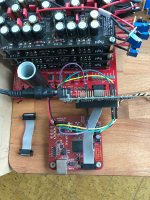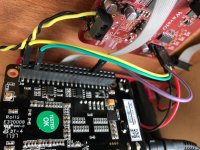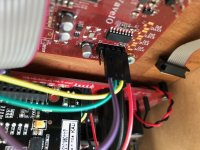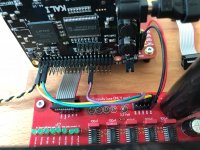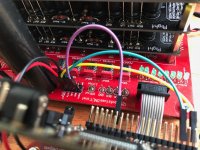I am assuming this is with all 100Ω reistors in the I2S input of the DAC boards (no 1kΩ for the clock delay).
The stock red mainboard does not have the "active" clock delay. It achieved the clock delay using an RC network (using a 1kΩ I2S coupling resistor instead of the 100Ω). I guess active circuits of the newer blue boards works as a buffer for the I2S and therefore allows driving more DAC boards.
HOWEVER, looking at the schematics at the DDDAC website, the only difference in the I2S inputs of the different DAC board versions I can see is the coupling resistors (100Ω/1kΩ/100Ω in the original version for the red mainboard, then 100Ω/100Ω/100Ω in the later version for the blue mainboard, and then the current "Tent" DAC boards don't have the coupling resistor values specified).
But since your tests with different I2S coupling resisors did not change anything, I'd tend to think the difference is elsewhere. I would not be surprised if the newer "Tent" DAC boards would consume more power. They might hit the current limit of the power supply a bit earlier than the "non-Tent" DAC boards. Have you looked into this?
I have a power supply that will supply 4.5A. The tent boards use about 200ma each so 3.3 A was no problem.
I have a power supply that will supply 4.5A. The tent boards use about 200ma each so 3.3 A was no problem.
I guess it might be interesting to trace the signals with a scope to see where thing start to go wrong.
you measured the POS and NEG against COMMON or against each other? The latter case would be ok. measuring against COMMON I would expect 4 values of course like 2.7 2.8 Volt. check this first pls
Sorry for the late reply, the values are
Right channel - com/pos = 2.825v, com/neg = 2.732v
Left channel - com/pos = 2.725v, com/neg = 2.743v
connecting a Kali between Wave I/O and a DDDAC
A question, especially to mbrennwa: I'm trying to connect a Kali via I2S between Wave and dddac. I know very little about digital and even about header connections. I know the numbers of the I2S input pins on the Kali, but I don't know if I have to plug male cables on the underside of the board, or use the corresponding top pins. I realize this is a very basic and possibly even stupid question, but I'm at a loss. Are there any other pointers you can give me?
Jan
A question, especially to mbrennwa: I'm trying to connect a Kali via I2S between Wave and dddac. I know very little about digital and even about header connections. I know the numbers of the I2S input pins on the Kali, but I don't know if I have to plug male cables on the underside of the board, or use the corresponding top pins. I realize this is a very basic and possibly even stupid question, but I'm at a loss. Are there any other pointers you can give me?
Jan
Sorry for the late reply, the values are
Right channel - com/pos = 2.825v, com/neg = 2.732v
Left channel - com/pos = 2.725v, com/neg = 2.743v
ok, so all ist fine in terms of the bias / analogue power...
A question, especially to mbrennwa: I'm trying to connect a Kali via I2S between Wave and dddac. I know very little about digital and even about header connections. I know the numbers of the I2S input pins on the Kali, but I don't know if I have to plug male cables on the underside of the board, or use the corresponding top pins. I realize this is a very basic and possibly even stupid question, but I'm at a loss. Are there any other pointers you can give me?
Jan
The I2S inputs on Kali are on the bottom header and the I2S outputs are the corresponding pins on the top header. MCLK comes out either from the u.fl on the bottom of the board or from Pin 29 on the top.
A question, especially to mbrennwa: I'm trying to connect a Kali via I2S between Wave and dddac. I know very little about digital and even about header connections. I know the numbers of the I2S input pins on the Kali, but I don't know if I have to plug male cables on the underside of the board, or use the corresponding top pins. I realize this is a very basic and possibly even stupid question, but I'm at a loss. Are there any other pointers you can give me?
Jan
Hi Jan
As Dimdim wrote: the WaveIO I2S output goes to the Kali I2S input at the bottom of the board. The Kali I2S I2S output from the top of the board goes to the DDDAC.
You don't need the MCLK connection. While the DDDAC has a pin for MCLK, it is not connected on the DDDAC; it's not used.
Note that the Kali + DDDAC combination is still a bit of a mystery. My first build using this combo works well. The second build did not work well (see here and follow up posts). I suspect the newer Kali boards (as in my second build) are somehow different from the older ones (as in my first build).
I posted a photo of my (messy) Kali + DDDAC setup in an earlier post. There are also a few other posts before that, which describe my adventure in getting the Kali + DDDAC working.
Remember that the WaveIO has an isolation between the USB side and the I2S output. This helps to avoid the USB noise creeping into the I2S signal. It is therefore a good idea to keep the power supplies of the WaveIO and the Kali separate from each other; otherwise you'd defeat the isolation. You could use the Vdd available from the DDDAC for the Kali, or you could use a dedicated power supply for the Kali. I tried both, and I didn't hear a difference.
Make sure you provide power to the isolated I2S output of the WaveIO. Without this, the WaveIO will not output any I2S signal. With the WaveIO connected directly to the DDDAC, this power is taken from the DDDAC Vdd supply. I used the Kali power supply for this in my setup.
Please report back if you can get your Kali + DDDAC combo to work.
Last edited:
Thanks. I connected Kali as described by you. On the dddac the Host active and Audio stream leds light up
That's the LEDs controlled by the WaveIO, correct?
but the only thing I hear is a loud crackle.
Does the crackle stop when you stop the music playback?
What do the LEDs on the Kali say?
Correct
Crackle stops when playback stops, audio stream led on dddac goes out, which is normal.
A lot of leds on the kali: without playback: 2xblue 2xgreen continuous, 1xred slowly flashing; with playback: 4 additional (small) green leds flashing, 2 additional (small) blue leds flashing, red led now flashing rapidly.
Crackle stops when playback stops, audio stream led on dddac goes out, which is normal.
A lot of leds on the kali: without playback: 2xblue 2xgreen continuous, 1xred slowly flashing; with playback: 4 additional (small) green leds flashing, 2 additional (small) blue leds flashing, red led now flashing rapidly.
A lot of leds on the kali: without playback: 2xblue 2xgreen continuous, 1xred slowly flashing; with playback: 4 additional (small) green leds flashing, 2 additional (small) blue leds flashing, red led now flashing rapidly.
I can't tell much from the colors, except that the red LED is probably the buffer underrun/overflow indicator. Take a close look at the labels next the LEDs. During normal playback, the buffer LED should be at "lock", the other LEDs should correspond to the sampling rate of the data stream.
The flashing LEDs probably mean that the Kali can't lock on the I2S data stream coming from the WaveIO. Are you sure all wires are connected correctly? How long are the wires? Maybe try inserting 100 Ohm resistors in the I2S lines at the Kali input to terminate the digital signals.
Can you send photos of your setup?
A friend just told me Kali doesn't work with the red dddac main board!
Welllllll... My red board does work with the Kali (see photo in my earlier post). But I have to say that my red board has the 1/2 clock modification, which may present a different load to the Kali I2S output than the stock I2S input of the red DDDAC board.
However, according to your Kali LED diagnostics, it seems that the Kali does not lock on to the WaveIO output. This is an issue upstream of your DDDAC board. Before ditching your red board, try to get the WaveIO + Kali working first:
- Make sure all I2S pins are connected correctly.
- Try shorter wires.
- Try 100 Ohm termination resistors.
A few pictures. BCLK purple wires, LRCLK green, DATA yellow
Two comments:
- It looks like the I2S-GND connections are missing. There may be a connection via the power supplies, but that's hard to tell from the photos. I'd think it's best to use direct GND wires for the I2S (both WaveIO/Kali and DDDAC/Kali).
- It looks like you're using three different power supplies: (1) DDDAC, (2) WaveIO, (3) Kali. Make sure the PSU 0V of the Kali and the DDDAC are connected to each other (which will be the case if you have a GND connection between Kali and DDDAC).
It looks like the I2S-GND connections are missing. There may be a connection via the power supplies, but that's hard to tell from the photos. I'd think it's best to use direct GND wires for the I2S (both WaveIO/Kali and DDDAC/Kali).
You're right, I only had a ground connection between Wave I2S and DDAC (5V feed from Vdd). I added a ground connection between Wave I2S and Kali's pin 39, and a connection between the spare power neg pin on the Kali (all grounds seem to be interconnected) and the dddac I2S ground.
It looks like you're using three different power supplies: (1) DDDAC, (2) WaveIO, (3) Kali. Make sure the PSU 0V of the Kali and the DDDAC are connected to each other (which will be the case if you have a GND connection between Kali and DDDAC).
Correct. For grounds see above.
Result: Kali is locked (blue led), and I now have music ... and crackle.
Thanks for your detailed instructions. Even if I'm not there yet, they took me a big step further.
Last thing I can try is inserting the 100Ohm resistors you recommend.
Jan
You're right, I only had a ground connection between Wave I2S and DDAC (5V feed from Vdd). I added a ground connection between Wave I2S and Kali's pin 39, and a connection between the spare power neg pin on the Kali (all grounds seem to be interconnected) and the dddac I2S ground.
It looks like you're using three different power supplies: (1) DDDAC, (2) WaveIO, (3) Kali. Make sure the PSU 0V of the Kali and the DDDAC are connected to each other (which will be the case if you have a GND connection between Kali and DDDAC).
Correct. For grounds see above.
Result: Kali is locked (blue led), and I now have music ... and crackle.
Thanks for your detailed instructions. Even if I'm not there yet, they took me a big step further.
Last thing I can try is inserting the 100Ohm resistors you recommend.
Jan
Last edited:
Result: Kali is locked (blue led), and I now have music ... and crackle.
Progress! The crackle might be related to the combination of the Kali with the passive 1/2 clock delay on the red board. Try the termination resistors both on the DDDAC I2S input and on the Kali input.
A few pictures.
By the way, what's that big black tube on your DDDAC board?
- Home
- Source & Line
- Digital Line Level
- A NOS 192/24 DAC with the PCM1794 (and WaveIO USB input)
